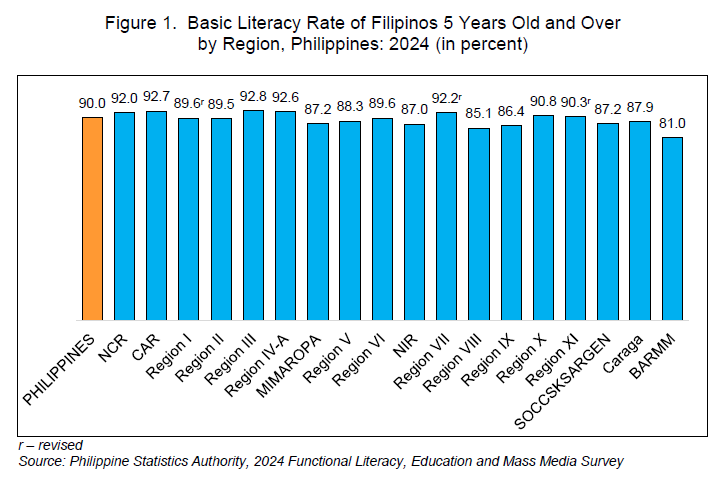The Philippine Statistics Authority (PSA) announced the key findings of the 2024 Functional Literacy, Education, and Mass Media Survey (FLEMMS), revealing that 90.0 percent, or 9 out of 10 Filipinos aged five (5) years and over, possess basic literacy. This significant achievement translates to approximately 93.09 million individuals who can read, write, and compute, out of an estimated 103.46 million in the same age group.
The FLEMMS 2024 survey provides a comprehensive snapshot of the literacy landscape across the archipelago, highlighting both progress and areas for continued focus.
Key Findings on Basic Literacy:
- Overall Achievement: The 90.0 percent basic literacy rate signifies a robust foundation in fundamental reading, writing, and numeracy skills for the vast majority of the population.
- Regional Disparities: While the national average is strong, regional variations exist. Central Luzon (Region III) leads with the highest basic literacy rate at 92.8 percent. Conversely, the Bangsamoro Autonomous Region in Muslim Mindanao (BARMM) recorded the lowest at 81.0 percent, indicating a need for targeted interventions.
- Gender and Age Trends: Females demonstrated a slightly higher basic literacy rate at 90.9 percent compared to males at 89.0 percent. The age group 20 to 24 years old exhibited the highest basic literacy at 96.1 percent, while Filipinos 60 years old and over reported the lowest at 76.2 percent.
- Illiteracy: The survey also identified that 6.9 percent, or about 7 out of 100 Filipinos aged 5 years and over, cannot read and write. BARMM recorded the highest proportion of illiteracy at 14.4 percent. Males (7.6%) had a higher illiteracy rate than females (6.1%), and the 5 to 9 years age group showed the highest proportion of individuals who cannot read and write at 20.1 percent, likely due to their early stage of schooling.
Key Findings on Functional Literacy:
Beyond basic skills, the survey also assessed functional literacy, which measures the ability to read, write, compute, and comprehend.
- Functional Literacy Rate: In 2024, the functional literacy rate stood at 70.8 percent, meaning about 7 out of 10 individuals aged 10 to 64 years are functionally literate. This represents approximately 60.17 million individuals out of an estimated 85.00 million in this age group.
- Regional Variations in Comprehension: The Cordillera Administrative Region achieved the highest functional literacy rate at 81.2 percent. Region IX (Zamboanga Peninsula) recorded the lowest at 59.3 percent.
- Gender and Age in Functional Literacy: Females again showed a higher functional literacy rate at 74.1 percent compared to males at 67.6 percent. Individuals aged 20 to 24 years maintained the highest functional literacy rate at 78.3 percent, while those aged 60 to 64 years had the lowest at 57.8 percent.
- Literacy Gap: Among individuals aged 10 to 64 years, 93.1 percent had basic literacy, but only 70.8 percent had functional literacy. This indicates that for every nine individuals in this age group who can read, write, and compute, two individuals experience comprehension difficulty. The gap between basic and functional literacy was most pronounced in the 60 to 64 years age group, where for every three individuals with basic literacy, one has comprehension difficulty.
“The 2024 FLEMMS results underscore the significant strides the Philippines has made in enhancing basic literacy across the population,” said PSA. “While we celebrate these achievements, the survey also provides crucial insights into areas where we need to intensify our efforts, particularly in improving functional literacy and addressing regional disparities, ensuring that all Filipinos not only read and write but also comprehend and apply information effectively in their daily lives.”
The PSA remains committed to providing timely and accurate statistics to inform policymaking and program development aimed at fostering a more literate and empowered Filipino populace.




